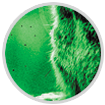How Night Vision Works
Night vision devices gather existing ambient light (starlight, moonlight or infra-red light) through the front lens. This light, which is made up of photons goes into a photocathode tube that changes the photons to electrons. The electrons are then amplified to a much greater number through an electrical and chemical process. The electrons are then hurled against a phosphorus screen that changes the amplified electrons back into visible light that you see through the eyepiece. The image will now be a clear green-hued amplified re-creation of the scene you were observing.
HOW NIGHT VISION WORKS
- Front Lens
- Photocathode
- Microchannel plate
- High Voltage Power Supply
- Phosphorus Screen
- Eyepiece
Why are the projected images always green using night vision technology?
A Night Vision phosphor screen is purposefully colored green because the human eye can differentiate more shades of green than other phosphor colors.
FIRST, SECOND, and THIRD GENERATION
A Night Vision Device can be either a 1st, 2nd, or 3rd generation unit. What this stands for is what type of light intensifier tube is used for that particular device The light intensifier tube is the heart and soul of an NVD.
1st Generation

1st generation is currently the most popular type of night vision in the world. Utilizing the basic principles described earlier, a 1st generation will amplify the existing light several thousand times letting you clearly see in the dark. These units provide a bright and sharp image at a low cost, which is perfect, whether you are boating, observing wildlife, or providing security for your home. You may notice the following when you are looking through a 1st gen unit.
- A slight high-pitched whine when the unit is on.
- The image you see may be slightly blurry around the edges. This is known as Geometric Distortion.
- When you turn a 1st gen off it may glow green for some time.
- These are inherent characteristics of a 1st gen and are normal.
2nd Generation

2nd generation is primarily used by law enforcement or for professional applications. This is because the cost of a 2nd gen unit is approximately $500.00 to $1000.00 more then a 1st gen. The main difference between a 1st and a 2nd generation unit is the addition of a micro-channel plate, commonly referred to as a MCP. The MCP works as an electron amplifier and is placed directly behind the photocathode. The MCP consists of millions of short parallel glass tubes. When the electrons pass through these short tubes, thousands more electrons are released. This extra process allows 2nd generation units to amplify the light many more times then 1st generation giving you a brighter and sharper image.
3rd Generation

By adding a sensitive chemical, gallium arsenide to the photocathode a brighter and sharper image was achieved over 2nd generation. An ion barrier film was also added to increase tube life. Gen. 3 provides the user with good to excellent low light performance.
Black spots on the screen

As you look through a night vision device you may notice black spots on the screen. A night vision device is similar to a television screen and attracts dust and dirt. Typically these spots can be cleaned. However, this may also be a spot in the tube itself. This is normal. Most tubes will have some spots in them. These black spots will not affect the performance or reliability of the night vision device, however, dark spots will be a distraction if they are large enough or located close to the center of the field of view. Dark spots can also obstruct detail in the target you are viewing. Night Vision Astronomy hand selects 100% clean used tubes for the BIPH. We also offer new tubes. The new tubes are not guaranteed to be clear of dark spots. Dark spot locations are marked in zone 1 (center of field of view), zone 2 or zone 3 which is the outer edge of the field. New Tube Military Specifications allow for 1 spot in zone 2 and another spot in zone 3 that is between 0.006" - .009" and they also allow for 2 spots in zone 2 and 2 spots in zone 3 that are between 0.003" - 0.006". While new tubes are allowed to contain dark spots within military specifications, it does not mean that every new tube has those dark spots. Every tube is different. If the new tube has dark spots, they will be within military specifications.